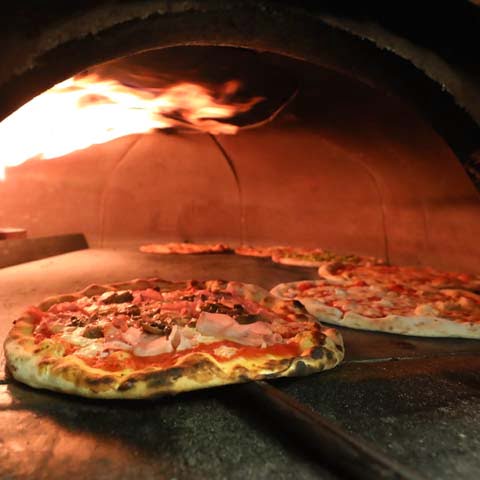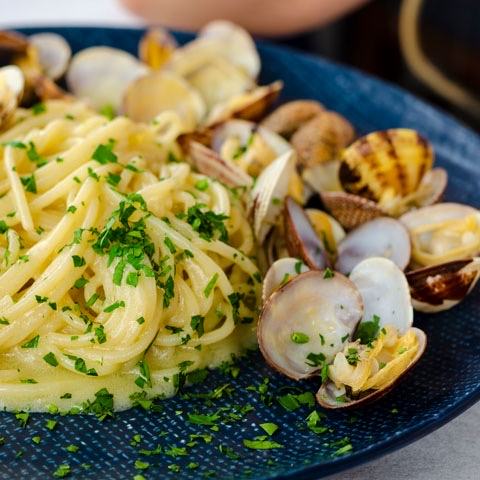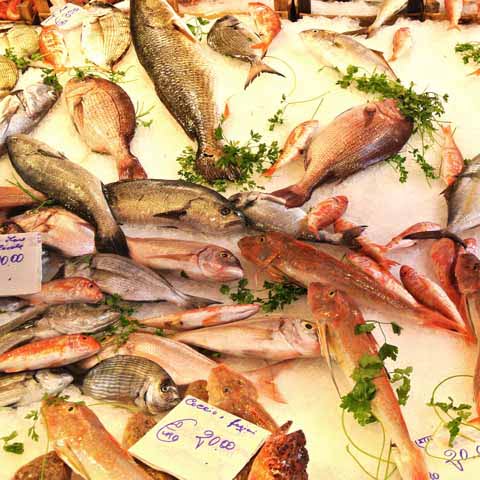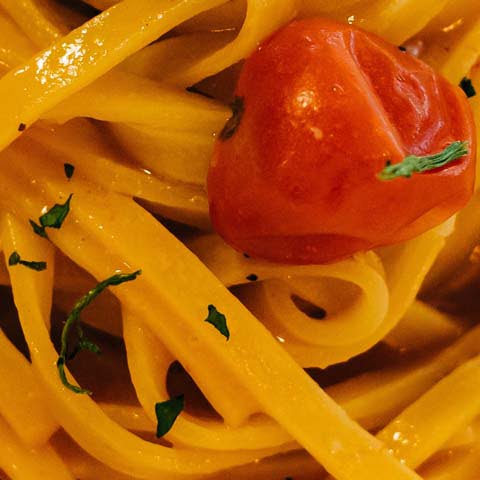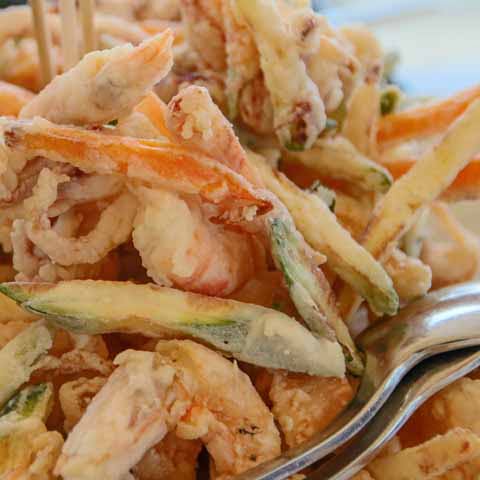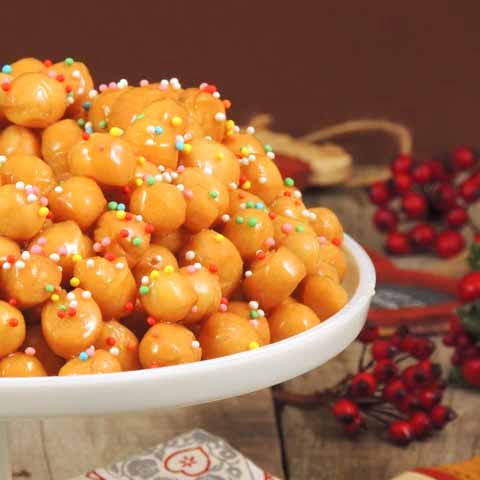Along the southwest coast of the boot of Italy is the thriving city of Naples, which is the birthplace of pizza and home to many traditionally renowned treats.
As one of Italy’s most distinct culinary traditions, the origins of Neapolitan cuisine date back to the Greek and Roman periods. Over the centuries, the local cuisine was shaped by peasant traditions as well as Naples’s role as the capital of the Kingdom of Naples. As a result, modern Neapolitan cuisine features elaborate dishes with international influences, namely French and Spanish, as well as modest recipes featuring local ingredients.
The principal ingredients that serve as the foundations of Neapolitan cuisine include pasta, tomatoes, locally grown vegetables, cheeses, seafood, pork, organ meats, cured meats, and fruit. Due to the coexistence of lower class and noble recipes, Neapolitan cuisine features a vast array of local specialties covering all courses of a meal — from appetizer to dessert — in addition to street food, special holiday recipes, coffee, wine and liqueurs.
When planning your trip to Naples, be sure to give yourself ample time to savor the remarkable Italian cuisine of this city. Enjoy the sights and sounds of this amazing metropolis while dining on freshly caught seafood, original homemade pizza, and some of the most beautiful and delicious desserts in all of Italy.
APPETIZER
Much of Neapolitan cuisine is fried or bread-based, and appetizers are certainly no exception. Some of the more popular starters are mozzarella in carrozza, bruschetta, crostini, and gattò (also known as gateau).
Mozzarella in carrozza is a staple of the area and one with a long-standing tradition. Originally invented as a way to use leftover mozzarella, this dish consists of mozzarella stuffed between two slices of bread that are dipped in beaten eggs, milk, and then fried. These fried triangle shaped bites make for fabulous comfort food.
Bruschetta and crostini are both served throughout Italy. However, the fresh ingredients and the use of local San Marzano tomatoes and pomodorini del piennolo del vesuvio make Neapolitan bruschetta and crostini stand out in a delightful way. These tomatoes are rich in flavor and a deep red in color due to the fertile volcanic soil adjacent to Mount Vesuvius. Made with homemade bread, freshly made mozzarella cheese, and locally grown tomatoes, Neapolitan bruschetta will likely make this dish unlike any other you have tried by the same name. In Naples, bruschetta as well as crostini may also feature other ingredients such as anchovies, olives, scamorza cheese, cured meats, pepper spreads, mushrooms, zucchini, and eggplants.
Gattò is a versatile dish that may be served as an appetizer, main course, or side dish. Gattò is made by mixing boiled potatoes with butter, eggs, prosciutto cotto or mortadella, scamorza cheese, and mozzarella. The mixture is topped with breadcrumbs and butter then baked until golden brown with a crispy crust.
Just like other parts of Italy, cured meats and cheeses are an important part of Neapolitan appetizers. In Naples, the most popular cured meats include salame napoletano, capocollo, and cicoli. The last item is made by compressing leftover pieces of pork. Fatty pieces are chosen to make cicoli, and after being compressed, the pieces are dried and aged. The final result is reminiscent of a chip.
As for cheeses, there is an abundance of local offerings to choose from. In Naples and the surrounding area, stretched-curd cheese reign supreme and none is more highly prized than the decadent mozzarella di bufala. Made exclusively from buffalo milk, the rich and buttery flavor of mozzarella di bufala makes it the Campania region’s top cheese.
A close second is fior di latte, which is made following the same methods as mozzarella di bufala except cow milk is used. Outside of Naples, fior di latte can be referred to as mozzarella.
Another popular stretched-curd cheese is provola, which can be made with cow milk or buffalo milk. During the aging process, the cheese is hung, giving it a distinct shape. This type of cheese can also be smoked, in which case it is called provola affumicata. Provola made with buffalo milk that is smoked is called provola affumicata di bufala. Another variation is provolone del Monaco, which is made in the area surrounding Naples with milk from Agerolese cows.
Scamorza is yet another stretched-curd cheese produced in the Naples area. This cheese is made using cow milk and, like provola, it is hung during the production process and it may also be smoked.
Several varieties of ricotta can also be enjoyed in the area including ricotta di fuscella (a fresh and light cow milk cheese), ricotta fresca (which can be enjoyed on its own or as a condiment), and ricotta salata (commonly enjoyed during Easter, this is the ricotta variety that is aged for the longest period of time).
FIRST COURSE
Pasta is a traditional and time-honored dish of Naples. Specifically, dried pasta is more prevalent in Naples and the Campania region thanks to the dried pasta tradition in the town of Gragnano. Whether it is in the form of spaghetti, maccheroni, paccheri, ziti, or linguine, pasta is served any way but plain in this city.
Before going too far into detail about different pasta specialties, it is worth noting one component that definitively sets local pasta apart, the ragù napoletano sauce. Neapolitan ragù is not a convenience food and takes hours to prepare. The base of the sauce consists of beef and pork spare ribs cooked in a San Marzano tomato sauce for several hours. This is not an everyday delight since so much work goes into making the ragù, but whenever it is enjoyed it will be well worth the wait. In Naples, ragù is typically served with ziti pasta.
Generally speaking, Neapolitan pasta dishes may range from simple and modest to rich and elaborate.
Among the simpler, yet still delicious preparations, are pasta al pomodoro (tomato sauce), aglio e olio (garlic and oil), pasta e fagioli (with beans), and puttanesca (tomato, olive oil, garlic, Gaeta olives, capers, and oregano). Special mention goes to spaghetti alla Gennaro, a dish dedicated to Naples’s patron saint that features anchovies, oregano, cherry tomatoes, and toasted breadcrumbs.
Frittata di pasta or frittata di maccheroni, is a recipe invented to use up leftover pasta. The dish consists of leftover pasta (often maccheroni, but other varieties, including long pastas, may be used as well), cheese, eggs, and cured meats. The ingredients are pan-fried and the final result is similar to an omelet that can be served hot or cold depending on preference.
Historically, a common rice dish among Naples’s lower classes was riso con la verza, or rice with cabbage served with parmigiano cheese and sometimes sausage, if it was available.
As for the richer dishes, we must mention genovese, which has nothing to do with the Ligurian city of Genoa, but is a Neapolitan sauce made with beef, onions, carrots, and celery. Typically served with ziti, this dish is fairly straightforward, though it is historically tied to the Neapolitan aristocracy due to the presence of choice cuts of meat.
Other key pasta dishes include maccheroni llardiati (made with lard and pecorino cheese) and pasta patate e provola (potatoes, provola cheese, and sometimes sausage is added).
Timballo is a category of elaborate dishes once popular among the Neapolitan noble class, but nowadays is not commonly prepared. The dish is an oven-baked casserole of sorts that may feature pasta, rice, meat, potatoes, or other ingredients. In some cases, the ingredients may be layered inside of puff pastry. Timballo was commonly prepared in other parts of Southern Italy as well, namely Sicily. One example of a Neapolitan-style timballo is sartù di riso, which consists of rice stuffed with chicken livers, sausage, small meatballs, fiordilatte or provola cheese, mushrooms, and peas. Sartù may be topped with ragù napoletano or it may be served on its own.
One dish dating back to the days of the French royal court is pasta al gratin, which is a type of timballo made from maccheroni mixed with bechamel, prosciutto, and mozzarella and covered with breadcrumbs.
Typically prepared during Easter, Casatiéllo is another elaborate dish that is characteristic of Neapolitan cuisine. This savory baked dish consists of bread filled with local cheese, ciccioli, salame, and eggs. One interesting aspect of this dish is that whole eggs are placed on the dough with their shells intact and the eggs are baked together with the rest of the dish.
Another category of pasta in Naples is pasta with mixed seafood (frutti di mare) and fish. The pasta shapes most commonly served with seafood include spaghetti, paccheri, and linguine. Many of the local seafood dishes are often served during special occasions, such as weddings.
One example is spaghetti alle vongole, which is served with clams, garlic, and white wine. In some cases, cherry tomatoes may be added. A variation of this dish is spaghetti ai frutti di mare (also called spaghetti allo scoglio), which features mixed seafood such as clams, mussels, shrimp, and more. Like spaghetti alle vongole, the dish may be served with or without cherry tomatoes.
Another common seafood pasta dish is pasta con i calamari, or calamarata, which is prepared with calamari and white wine.
Risotto alla pescatora, is a first course seafood dish made with rice. Like spaghetti ai frutti di mare, it may feature a wide variety of seafood such as clams, calamari, cuttlefish, octopus, and shrimp. The rice is flavored with a broth made from the shells of the seafood.
Soups are another popular category of first course dishes and there are several varieties that are native to Naples.
One must-try is minestra maritata. This dish consists of cabbage and chicory (or other available local vegetables) cooked in beef broth with herbs, pork sausage, and/or beef. Traditionally, this hearty soup is made for lunch on Christmas and Easter.
Pasta e patate, a thick soup made with pasta and potatoes, was once a common winter staple among the peasant population. Today it can be enjoyed in some of Naples’s restaurants.
Other local soups tend to feature a pairing of vegetables and legumes, such as minestra di scarola e fagioli, which is made with escarole and beans.
PIZZA
Naples’s most famous local specialty, Neapolitan pizza, deserves a category all its own. Traditionally, pizza napoletana is served during a sit-down meal as a piatto unico, or single dish.
Pizza is the gold standard of Neapolitan fare and it originated here. Neapolitan pizza has actually been declared a Traditional Specialty Guaranteed Product in Europe. It was also granted the Denomination of Control (DOC) status in Italy, and it was added to the UNESCO List of Intangible Cultural Heritage.
A traditional Neapolitan pizza is made in a wood-fired oven and baked at 905 °F for 60 to 90 seconds. The result is a soft, elastic middle with a slightly charred crust.
Pizza in Naples is a far cry from an American pizza. In order to make true Neapolitan pizza, specific ingredients of the highest quality must be used. The city’s pizzas are made with the unmistakable magic of tomatoes grown in the volcanic soil of Mount Vesuvius (San Marzano or Pomodoro del Piennolo), locally made buffalo mozzarella, type 0 or type 00 flour, fresh basil, and olive oil. It is worth noting that many of these pizzas incorporate ingredients that are red, white, and green, the very same colors found on the Italian flag.
If adhering to strict tradition, Neapolitan pizza can be made in two official varieties: marinara and Margherita. Marinara is a simple yet divine pizza comprised of tomato, garlic, oregano, and oil. Pizza Margherita, on the other hand, is a legendary pizza that was made to welcome Queen Margherita of Savoy to Naples. This classic pizza consists of tomato, mozzarella di bufala, basil, and olive oil.
In addition to the two official preparations of Neapolitan pizza, other variations with different ingredients have become popular in Naples over the centuries.
A few examples include capricciosa (mushrooms, artichokes, prosciutto cotto, olives, tomato, mozzarella, grana cheese, and basil), quattro formaggi (a white pizza with mozzarella and three other local cheeses, such as provola, which can vary), and diavola (pomodoro, mozzarella, grana, basil, and spicy salame).
Some pizzerie in Naples may also feature a variety of other ingredients on their pizzas, based on the creativity of the pizzaiolo. However, when in Naples you must try the classic pizza Margherita at least once before branching out.
Several similar dishes have been born out of traditional pizza napoletana. Among these, the most popular among Neapolitans is pizza fritta, or fried pizza. Made using the same dough as pizza napoletana, pizza fritta is fried in oil and may be served on its own, or stuffed with a variety of ingredients such as cicoli with provola, mozzarella with prosciutto cotto, and many others. Additionally, when the stuffed dough used to make pizza fritta is folded into a half-moon shape and baked, rather than fried, it is called a calzone. Typical calzone fillings include tomato and mozzarella, prosciutto, provola, ricotta, salame napoletano, and more.
Both pizza fritta and calzoni can be enjoyed on the go as well, making them part of Naples’s street food tradition (see section below).
Pizza di scarola is a pizza that looks more like a pie. The oven baked dough is filled with escarole, black olives, capers, pine nuts, and anchovies.
SECOND COURSE
Because of Naples’ proximity to the Tyrrhenian Sea, many of the city’s second courses are seafood-based. Some of the popular sea fare found here includes clams, squid, octopus, mussels, shrimp, anchovies, prawns, and cuttlefish.
For every type of seafood on the menu, there are typically dozens of unique ways to prepare and serve it. While the individual dishes created with a combination of freshly caught seafood and locally grown vegetables are far too vast to summarize here, there are a several traditional dishes worth noting.
Generally speaking, local varieties of medium sized white fish tend to be prepared all’acqua pazza, which means they are cut into smaller pieces, poached in broth with garlic and cherry tomatoes, and topped with parsley. Larger fish tends to be served whole either grilled or steamed and sometimes accompanied by prawns.
Baccalà, or dried and salted cod, is common in Naples and is typically prepared in cassuola (also called alla napoletana), which means the cod is slowly cooked in tomato sauce and served with pine nuts, capers, and raisins.
Impepata di cozze is an often-requested mussel dish. Generally, this favorite features steamed mussels seasoned with black pepper and served with parsley and lemon juice. While this dish is delicious in its own right, diners often prefer a side of homemade bread to help soak up every drop of the savory juices of impepata di cozze.
Anchovies are traditionally prepared in a few different ways, namely fried whole (alici dorate e fritte), marinated in lemon juice or vinegar (alici marinate), or quickly sauteed with garlic and oregano then seasoned with lemon juice or vinegar (alici arreganate).
Other small local fish called cicenielli (whitebait) are typically poached or fried.
Speaking of fried foods, fritto misto, which consists of mixed fried seafood, is quite popular in Naples as well as other parts of Italy. Depending on the portion size, it may be served as an appetizer, second course, or even a street food.
Another Neapolitan seafood staple is fagioli con le cozze, or beans with mussels. Thanks to the beans, this dish has a dense and filling consistency that historically made it popular among Naples’s poorer classes. Pasta may be added to the dish as well, in which case it is typically served as a first course.
Though Naples is not widely known for its meat dishes, mainly because meat was not widely available among the poorer population for centuries, there are a few second course dishes that feature meat.
One popular meat dish is salsicce e friarielli, which consists of pork sausage served with sauteed rapini or broccoli rabe, and sometimes potatoes. In Naples, sausage is usually coarsely ground. One distinct type of pork sausage that is local to Naples is called cervellatina (typically referred to in the plural form, cervellatine). These uncured sausages are thinner than other varieties, usually between 0.4 and 0.8 inches, and they can vary in length from 12 inches to more than three feet. The pork is usually seasoned with ground black pepper before being placed in the casing. Cervellatine are usually served with rapini or potatoes.
A common way to prepare veal is vitello alla pizzaiola. This dish features thin slices of veal cooked in tomato sauce, garlic, and oregano. In some cases, cheese such as provola or mozzarella may be added on top of the veal.
Goat and lamb are typically served during Easter celebrations. The meat is prepared in a simple way by roasting it with potatoes and peas.
Naples is also home to several vegetable-based second course dishes. Depending on the portion size, these dishes could also be served as a side dish or appetizer.
The most prominent is Parmigiana di Melanzane, which can be found in nearly every Neapolitan restaurant. Fried eggplant is the star of this baked dish and is layered with homemade tomato sauce, basil, mozzarella (or provola), and parmigiano. The flavors of the San Marzano tomatoes, garlic, onions, and olive oil make the dish come alive.
Stuffed peppers are popular in Naples as well. The filling typically features olives, capers, and breadcrumbs. A similar dish is melanzane a barchetta, which consists of halved and emptied eggplants stuffed with sauteed eggplant, cheese (provala or mozzarella), anchovies, cherry tomatoes, olives, capers, and breadcrumbs.
Additionally, many local vegetables, specifically artichokes, zucchini, and cauliflower are often fried. For a more substantial dish, liver and ricotta are often added.
SIDE DISHES
Similar to the rest of Italy, the majority of side dishes in Naples are vegetable-based.
Side dishes local to Naples include zucchini alla scapece (fried zucchini with vinegar and mint), melanzane a funghetti (an eggplant dish that can be prepared in two ways: cut into strips, fried, and served with cherry tomatoes or cut into cubes and sauteed), peperoni in padella (sauteed bell peppers with Gaeta olives and capers), peperoni a gratè (a baked dish consisting of bell peppers, olive oil, garlic, parsley, olives, and capers and topped with breadcrumbs), friarielli (sauteed rapini, which are typically paired with sausage or cervellatine), and scarole alla monachina (sauteed escarole served with Gaeta olives, capers, pine nuts, raisins, and salted anchovies).
STREET FOOD
In the thriving city of Naples, there are almost more street food options than those you will find on a menu at a local restaurant.
Several typical street food recipes derive from the classic Neapolitan pizza. One example is pizza a portafoglio, which consists of a whole pizza folded into four parts and eaten on the go. Pizza fritta, fried pizza dough stuffed with a variety of local ingredients, is a popular street food as well. A variation of pizza fritta, called canzone, that can also be enjoyed on the go, is made by folding the stuffed dough into a half-moon shape and baking it instead of frying it.
Speaking of fried pizza, a vast amount of Naples’s street foods are fried. Crocchè, potato croquettes stuffed with cheese and/or cured meats, are an excellent example. Usually served in paper cones called cuoppi, crocchè may be accompanied by a variety of other fried street foods, such as pastacresciute (rustic fritters), scagliozzi (slices of fried polenta), sciurilli (fried squash blossoms), palle di riso (small fried rice balls), and fried eggplant slices.
Panini fritti are another excellent fried street food. These consist of fried bread, which may be empty or filled with cured meats, cheeses, and more.
Panino napoletano is a popular sandwich of sorts. This homemade hollow bread is filled with savory chunks of cured meats, such as salame napoletano, and cheeses, such as provola or mozzarella.
Several historic Neapolitan specialties characteristic of the peasant cooking tradition can now be enjoyed as street foods. Examples include trippa (tripe) and ‘o pere e ‘o musso (poached pig’s feet and veal head served chopped with salt and lemon juice).
It is also possible to enjoy taralli, ring-shaped crackers also found in the Apulia region, which in Naples are made with lard and seasoned with black pepper.
A favorite among the older generations of Neapolitans is ‘o spassatiempo, which consists of mixed nuts, squash seeds, toasted chickpeas, and pickled lupin beans.
In the summer months, Neapolitans enjoy ‘a rattata, which consists of shaved ice flavored with a sweet syrup. The most popular flavors are almond milk, black cherry, and mint.
Zeppole di San Giuseppe are another sweet treat that can be enjoyed on the streets of Naples. Traditionally, these sweets were made for the Feast of Saint Joseph, though nowadays it is not unusual to find them available year-round as a street food. Zeppole consist of small doughnuts that can either be fried or baked, are covered with powdered sugar, and topped with custard cream and preserved black cherries. Interestingly, in Naples, pastacresciute are considered to be a savory version of zeppole and these street food fritters may be referred to as zeppole by the locals as well.
DESSERT
One of the most often requested and traditional desserts of Naples with roots tracing back to the early nineteenth century is the divine sfogliatella. This pastry treat is as beautiful as it is delicious. The pastry is usually in a rounded triangle shape that resembles a seashell with many delicate layers. The exterior of this sweet treat is crisp and lightly dusted with powdered sugar. Although the filling generally consists of sweet ricotta and candied fruit, it is sometimes filled with other mixtures such as almond paste, jam, or chocolate. Additionally, sfogliatelle are actually available in two versions. The first is sfogliatella riccia, which is the layered version described above, while the second is sfogliatella frolla, which is also filled, but is made from short-crust pastry and does not have the layers of the sfogliatella riccia.
Possibly only second to sfogliatelle in tradition and popularity is babà. This yeast cake is thoroughly soaked in rum and sugar syrup and can be filled with cream or chocolate. Making this sweet treat is time intensive due to long dough rising, baking, drying, and soaking phases. The final product is shaped much like a mushroom and can be garnished with homemade whipped cream and fresh berries, though often it is served plain.
Several Neapolitan desserts were invented in celebration of specific holidays. One such example is known as struffoli. Traditionally made during Christmas, these small balls of fried dough are sweetened with a drizzle of honey and are usually topped with brightly colored sprinkles. At Christmas, the balls are stacked on top of each other in a cone shape or they can be arranged into a ring. It is believed that the recipe for struffoli actually originated with the Ancient Greeks.
Another dessert tied to a holiday is pastiera napoletana, which is prepared during Easter. This short-crust dessert resembling a tart or lattice pie is filled with a mixture of ricotta, candied fruits, eggs, and wheat boiled in milk. The result is a crunchy crust with a bright golden yellow color and a soft center. Various spices or other ingredients may be added based on personal preference such as cinnamon, orange zest, and vanilla.
Neapolitans celebrate Carnival with graffe napoletane. Made from flour and potatoes, these special doughnuts are fried and then covered with powdered sugar. Though they are traditionally associated with the Carnival period, today they can be purchased year-round in Naples.
Outside of a specific holiday, Neapolitans may also enjoy a dessert called testa di moro. This sweet consists of rounded sponge cake filled with custard cream that is covered with a thin layer of cream or chocolate cream and topped with crumbled chocolate. One variation, made without chocolate, is covered with crumbled hazelnuts.
Locals and visitors alike will tell you that these desserts are enough of a treat all on their own. Yet, the secret to a truly delightful meal is concluding with a Naples espresso. Neapolitans take their coffee very seriously and they believe that Neapolitan coffee is unique due to its aroma and consistency. Neapolitans have greatly contributed to Italian coffee culture with their traditional cuccumella coffee maker, which inspired the popular moka coffee maker that is now synonymous with homebrewed Italian coffee.
Naples is also the birthplace of the caffè sospeso (pending coffee), a practice that involves paying for an extra cup of coffee that will be given anonymously to a future customer. Historically, a person who did not have the money to purchase a coffee, would ask if any suspended coffees were available and would be served for free. This response to economic hardship became a way of promoting kindness in the community, and now caffè sospeso has spread throughout Italy and the rest of the world.
WINE IN NAPLES ITALY
The fertile valley next to the volcano Mount Vesuvius, which is rich in tuff and volcanic ash, in combination with the Mediterranean climate yields approximately seven DOC wines from the greater Naples area.
The Asprinio di Aversa zone produces much of the wine from the area. It produces most of its dry white wines from at least eighty-five percent Asprinio grapes. However, in its most popular form Asprinio di Aversa is a dry sparkling wine made from one hundred percent Asprinio grapes.
Also popular in Naples are Lacryma Christi wines, which are available in white, red, and rosé varieties. Interestingly, this particular wine is thought by archaeologists to be similar to the wine of Ancient Rome.
Naples is the best place to try wines made throughout the Campania region, including the reds Taurasi, Aglianico, Piedirosso, and Solopaca, and the whites Greco di Tufo, Falanghina, and Fiano di Avellino.
In addition to coffee, Neapolitans tend to end their meals with a strong digestif. Limoncello, originally from the Campania region, is now the most common digestif throughout Italy. Another local favorite is nocillo, which is made from the husks of unripe walnuts and can be found in other regions of Italy as well, usually under the name nocino.
The restaurants and streets of Naples hold many delicious treats, both sweet and savory. Feel free to enjoy a little bit of everything and take pizza night to a whole new level in the beauty of Naples, Italy.
Don't just see Italy, live it.
Your dream trip to Italy has never been closer
No more endlessly scrolling travel sites. Our travel experts will craft the perfect, one-of-a-kind trip just for you.

300+
DESTINATIONS
We offer more Italian destinations than any travel site. Do and see more with Trips 2 Italy.
1 (of a kind)
ITINERARIES
Because your dream trip to Italy should be designed for you, not for the masses.
100%
PEACE OF MIND
From flights and accommodations, to food and activities - we take care of every detail.
